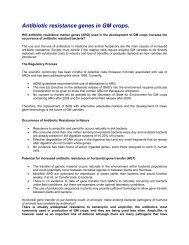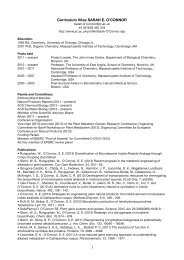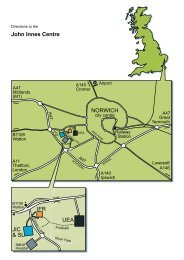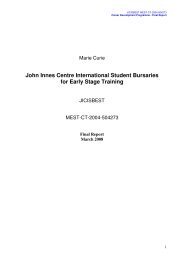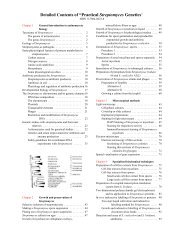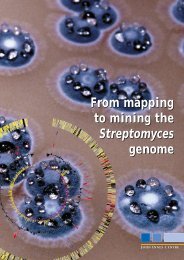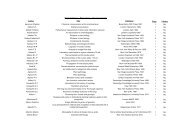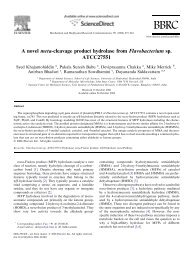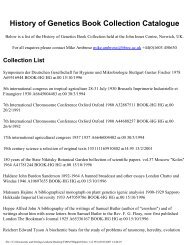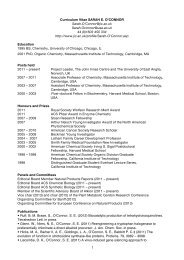1910s Timeline - John Innes Centre
1910s Timeline - John Innes Centre
1910s Timeline - John Innes Centre
You also want an ePaper? Increase the reach of your titles
YUMPU automatically turns print PDFs into web optimized ePapers that Google loves.
1930s L F La Cour develops<br />
new cytological techniques<br />
In 1929 Len La Cour publishes<br />
his first paper on ‘New fixatives<br />
for plant cytology’ in Nature.<br />
This is followed up in 1931 by<br />
‘Improvements in everyday<br />
technique in plant cytology’ in<br />
the Journal of the Microscopical<br />
Society. These modestly titled<br />
contributions mark the start of<br />
La Cour’s career as a pioneer in<br />
the development of techniques<br />
for studying the chromosomes<br />
of plants (and animals). By this<br />
time he has become highly<br />
skilled in the preparation of<br />
chromosomes from a wide<br />
variety of difficult material from<br />
ferns to flowering plants and<br />
insects. At the age of 24 he is<br />
acknowledged as the expert in<br />
this field and he mentors all<br />
students who come to JIHI to<br />
see chromosomes. His<br />
experiments yield important<br />
improvements in pre-treatment,<br />
fixation, embedding and<br />
staining of material. Before his<br />
work methods, all using light<br />
microscopy, were only just<br />
satisfactory for ‘easy’ species<br />
with low numbers of large<br />
chromosomes. Even simple<br />
chromosome counts were<br />
fraught with problems, and each<br />
species and tissue required<br />
different treatments. La Cour’s<br />
techniques helped reveal the<br />
inner structure and coiling of the<br />
chromosomes, and Darlington’s<br />
contributions to cytological<br />
theory were based on his<br />
preparations. La Cour has<br />
worked his way up from his first<br />
job as a lab-boy, whose tasks at<br />
Merton included cleaning<br />
windows.<br />
See also:<br />
Dan Lewis, ‘Leonard Francis La<br />
Cour 1907-1984’, Biographical<br />
Memoirs of Fellows of the Royal<br />
Society, 32 (1986): 357-375<br />
1931 Geneticists in USA<br />
provide cytological proof of<br />
crossing-over<br />
Harriet B. Creighton and<br />
Barbara McClintock, at Cornell<br />
University, Ithaca, New York,<br />
demonstrate cytological proof<br />
of crossing-over in maize. Their<br />
work shows that genetic<br />
recombination is caused by a<br />
physical exchange of<br />
chromosomal pieces.<br />
Darlington had laid the<br />
foundations of this idea in his<br />
work on meiosis in 1929-30. In<br />
contrast to ‘classical’ cytological<br />
theory, which favoured a system<br />
that retained the integrity of the<br />
chromosome, Darlington’s<br />
theory required breakage and<br />
rejoining of chromatids as the<br />
cause of crossing-over and the<br />
exchange of genetic<br />
information.<br />
See:<br />
C. D. Darlington, ‘A cytological<br />
demonstration of ‘genetic’<br />
crossing-over (Hyacinthus)’,<br />
Proc. Royal Society of London, B,<br />
107 (1930): 50-59.<br />
Dan Lewis, ‘Cyril Dean<br />
Darlington 1903-1981’,<br />
Biographical Memoirs of Fellows<br />
of the Royal Sociey, 29 (1983):<br />
113-157, esp. pp. 131-32.<br />
1931 JIHI affiliates to the<br />
University of London for postgraduate<br />
research and higher<br />
degrees<br />
The liberal policies of the<br />
University of London allow<br />
workers at affiliated research<br />
institutes to register for higher<br />
degrees without any formal or<br />
informal contact with a college<br />
or school of the University. This<br />
arrangement remains until<br />
1960.<br />
Page 20 of 91



